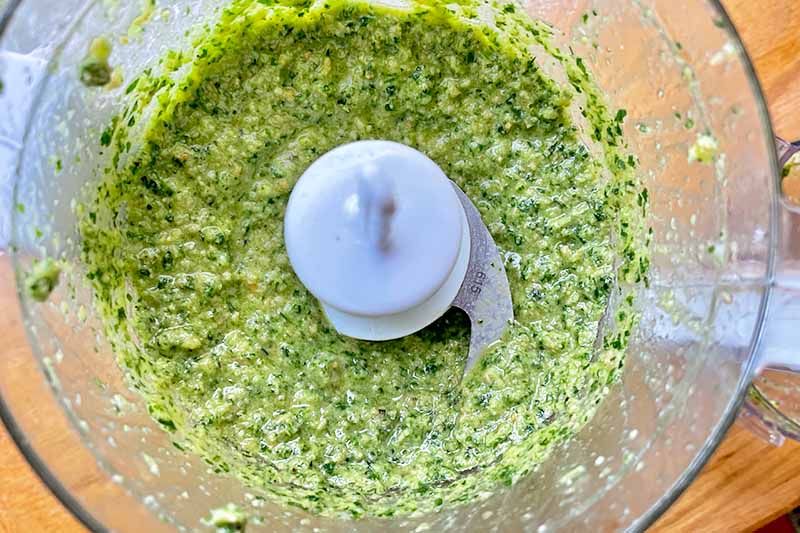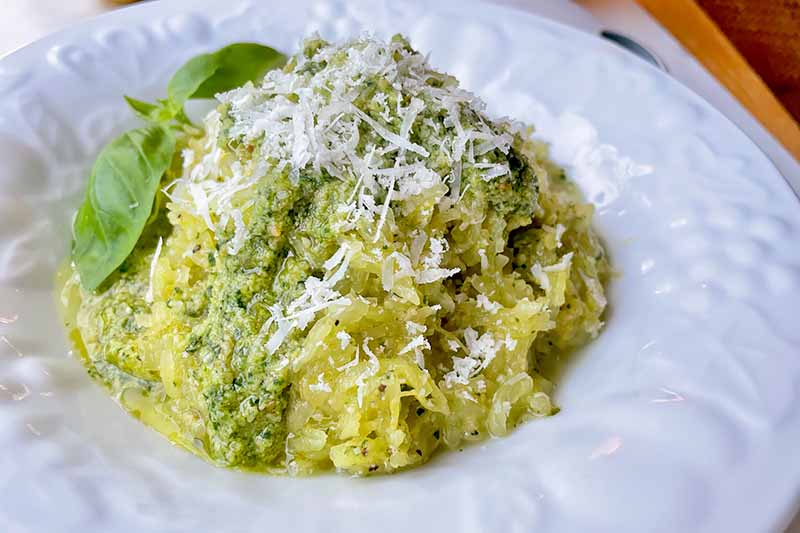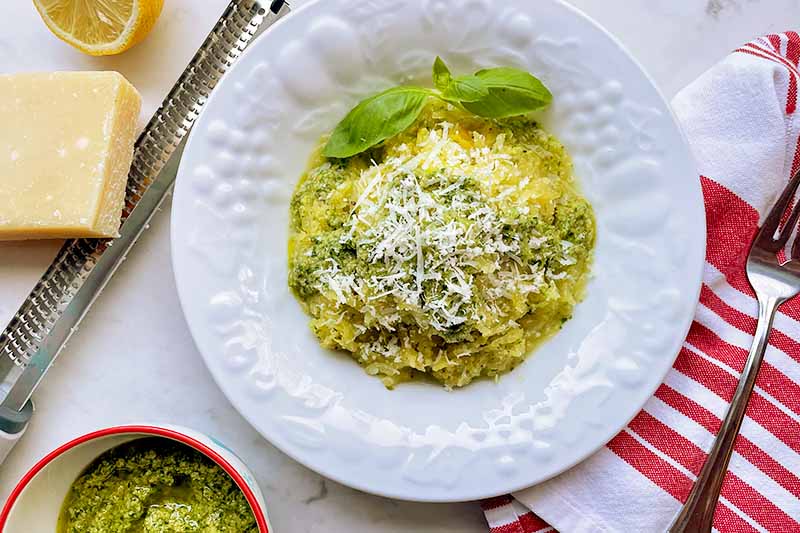I’m not going to sit here and try to convince you that spaghetti squash will flawlessly fill the void left behind by regular noodles.

But they do make one heck of a satisfying substitute.
As far as recipes are concerned, forkfuls of spaghetti squash are certainly interchangeable with standard flour-based pastas and noodles. In a pinch, they’re a great gluten-free substitute to twirl around sauce, or add to a spicy soup.
But texturally, the two aren’t identical.
To be perfectly honest, sometimes I actually prefer the delicate, thread-like pieces of squash to carb-heavy noods.
You can’t deny the lightness in your belly that comes from devouring a mound of veggies swirled in a familiar sauce versus a pound of linguine. And at the end of the day, isn’t it really about the sauce? Unless you’ve got a tummy ache, you’re probably not going near a plate of naked noodles.
And that, ladies and hungrymen, brings me to today’s pesto.

This vibrant, versatile mixture is simplicity at its finest. Other than the lightly toasted nuts, the velvety sauce is as fresh and raw as they come.
From the pungent garlic to the nutty parmesan cheese to the brightness brought to you by a squeeze of lemon, this pesto is perfection.
Though pine nuts are the traditional option, I often reach for whatever nut or seed I have within arm’s reach. Sunflower seeds and pistachios are two of my go-to’s, and once toasted and blended into the mix, I don’t notice much of a difference in terms of the final outcome.
The fragrant perfume of the basil kind of takes over the whole show, anyway. And I’m totally okay with that.

The acidity from the lemon juice cuts the sharpness of the garlic, and a handful of parsley lends even more herbaceous flavor.
It’s kind of magical how just a few ingredients can create such an explosive impact on your taste buds when they’re melded together. But don’t forget to shout “abracadabra” before you break out the food processor! It really makes a difference.
If you’re a spaghetti squash novice and confused as to why we’re turning it into pasta instead of pie, let me put your mind at ease. While the other winter squashes you’ll commonly see in the grocery store (butternut, acorn, and the like) are known for their almost-sugary-sweet characteristics, the flavor of the spaghetti variety is mild and neutral.

There’s a subtle sweetness, but this heavy, oval-shaped veg is most prized for its ability to transform into string-like pieces when it’s cooked. Clearly, this makes it an ideal partner for anything pasta-related, and it’s easy to swirl together a sauce or a puree with it. I’ve used it paired with a classic marinara sauce, and have explored bolder flavors when I combined it with my parsnip and beet puree.
Above all, though, I’m a big fan of pesto! The pungency of the pesto in this recipe wakes up every mouthful.
The sauce is easy to whip up (as long as you don’t burn the pine nuts – if you do, toss ‘em and start over), so it’s the squash you’ll want to pay close attention to while you’re working in the kitchen. Roasting it for too long at too low of a temperature can result in mushy “noodles.”
You want to produce ones that are tender-crisp and have a slight bite to them. Got it?
Alright, I think you’ve been schooled enough in spaghetti squash. Now let’s make some magic.
Print
Pesto Spaghetti Squash
- Total Time: 55 minutes
- Yield: 4 servings 1x
Description
This quick supper tangles oven-roasted al dente strands of spaghetti squash with buttery, scratch-made basil and parsley pesto.
Ingredients
- 1 large spaghetti squash, halved lengthwise and seeded (about 4 lbs)
- 1/4 cup plus 2 tablespoons olive oil, divided
- 1 teaspoon coarse kosher salt, divided, plus more to taste
- 1/2 teaspoon ground black pepper, divided, plus more to taste
- 3 large cloves garlic, peeled
- 1/4 cup pine nuts, toasted
- 1/2 cup lightly packed fresh parsley leaves
- 1 cup packed fresh basil leaves, plus more for garnish
- 1/4 cup grated parmesan cheese, plus more for garnish
- 1 tablespoon freshly squeezed lemon juice
Instructions
- Preheat the oven to 425°F and line a baking sheet with parchment paper.
- Drizzle the interior of the squash with 2 tablespoons of the oil. Season with 1/2 teaspoon of the salt and 1/4 teaspoon of the pepper.
- Place the squash halves cut side down on the prepared baking sheet. Bake until fork-tender, about 25-30 minutes. Set aside to cool.
- In the bowl of a food processor, puree the garlic, toasted pine nuts, parsley, basil, parmesan, lemon juice, remaining 1/2 teaspoon salt, and 1/4 teaspoon pepper.
- With the motor still running, slowly stream in the olive oil. The mixture will be smooth and velvety. Season to taste with additional salt if necessary.
- Using a fork, shred the flesh of the squash and transfer it to a large bowl. Toss the strands with the pesto, season to taste with salt and pepper, and then divide among bowls. Garnish with the additional parmesan and basil, and serve.
- Prep Time: 20 minutes
- Cook Time: 35 minutes
- Category: Squash
- Method: Baking
- Cuisine: Vegetarian
Keywords: pesto, spaghetti squash, vegetarian
Cooking By the Numbers…
Step 1 – Prep the Squash
Preheat the oven to 425°F and line a baking sheet with parchment paper.
Cut the squash in half lengthwise and scoop out the seeds.

Drizzle the interior of the squash with 2 tablespoons of the oil and season with 1/2 teaspoon of the salt and 1/4 teaspoon of the pepper.
Place the squash halves cut side down on the prepared baking sheet. Bake until fork-tender, for about 25 to 30 minutes. Set aside to cool.
Roasting the squash for too long will result in mushy flesh. You want the texture of the strands to be similar to al dente pasta.
Step 2 – Prep Remaining Ingredients and Make the Pesto
In a small dry skillet over medium-low heat, add the pine nuts. Shaking the pan and tossing occasionally to promote even browning, cook until golden and lightly toasted, for about 5 minutes.

Be sure to keep an eye on things, so they don’t burn! Remove from the pan when they’re done so they’ll stop cooking.
Juice the lemon, remove any seeds, and measure out what you need.
Grate the cheese, and measure out all of the remaining ingredients.
In the bowl of a food processor, add the garlic, pine nuts, parsley, basil, parmesan, lemon juice, remaining 1/2 teaspoon of the salt, and 1/4 teaspoon of the pepper.
Pulse and then puree until combined, scraping down the sides of the food processor as needed with a rubber spatula.

With the motor running, slowly stream in the olive oil. The mixture will be smooth and velvety. Again, scrape down the sides as needed.
If you’re using a mini food processor and it doesn’t have a place to stream in the olive oil through the lid, just pulse it in a few tablespoons at a time.
Season to taste with additional salt if necessary.
Step 3 – Shred the Squash
Using a fork, shred the flesh of the squash by scraping it from the outside and working your way in, fluffing the strands as you go. You can use the flesh all the way down to the skin.

Transfer the strands to a large bowl.
Step 4 – Toss with the Pesto and Serve
Toss with the pesto, season to taste with salt and pepper, and then divide among bowls.

Garnish with the additional parmesan and basil, and serve.
Swirly Twirly Spaghetti Squash
If you long for the lovely combination of pesto and pasta, but need to keep things gluten-free or low-carb-friendly, this light supper is sure to satisfy your craving.

Did you fork out your roasted strands a touch too early? Let them mingle with the pesto in a pan over medium heat, tasting as you toss. The additional cooking time will soften them to your liking.
Not cooking for a gaggle of vegetarians? Throw in some lemony chargrilled chicken for a little more oomph. For those looking to bulk things up while keeping the meal meat-free, protein-packed chickpeas or marinated tofu make great mix-ins.
Looking for more good eats that are gloriously gluten-free? Give these recipes a try next:
- Gluten-Free Salt and Vinegar Baked Fish
- Juicy 4-Ingredient Salsa Verde Chicken Bake
- Easy, Healthy Sheet Pan Sausage and Vegetables
Sliced cherry tomatoes can bring a pop of red to this green-hued plate, or you can make our version with sun-dried tomatoes and feta! How will you brighten up your meal? Share your colorful ideas in the comments below! And don’t forget to give this recipe a five-star rating if you loved it.
Photos by Fanny Slater, © Ask the Experts, LLC. ALL RIGHTS RESERVED. See our TOS for more details. Originally published by Lorna Kring on October 21, 2015. Last updated on September 28, 2021.
Nutritional information derived from a database of known generic and branded foods and ingredients and was not compiled by a registered dietitian or submitted for lab testing. It should be viewed as an approximation.
About Fanny Slater
Fanny Slater is a home-taught food enthusiast based in Wilmington, North Carolina who won the “Rachael Ray Show” Great American Cookbook Competition in 2014, and published her cookbook “Orange, Lavender & Figs” in 2016. Fanny is a food and beverage writer, recipe developer, and social media influencer. She was a co-host on the Food Network series “Kitchen Sink,” was featured on Cooking Channel’s longtime popular series “The Best Thing I Ever Ate,” and continues to appear regularly on the “Rachael Ray Show.”




